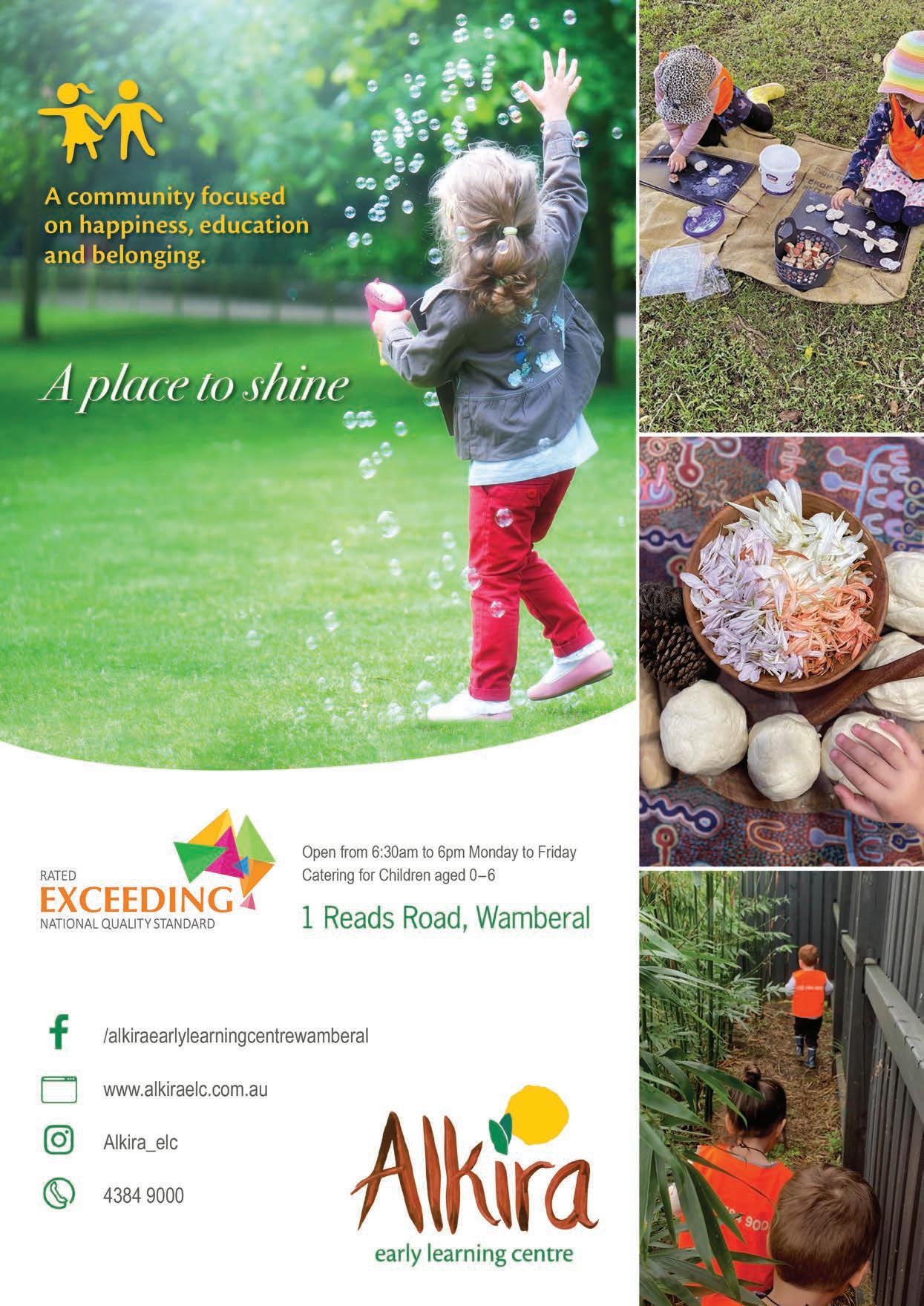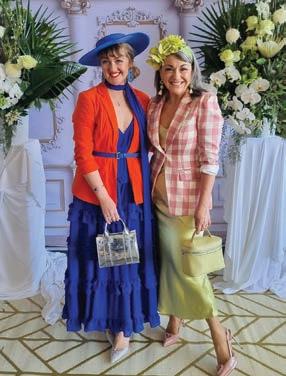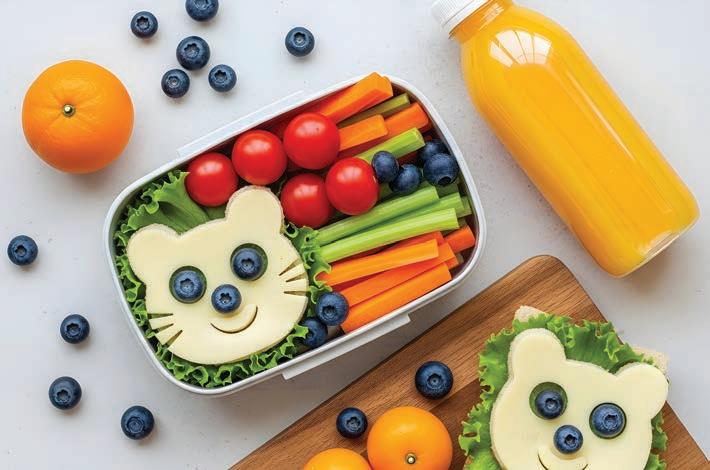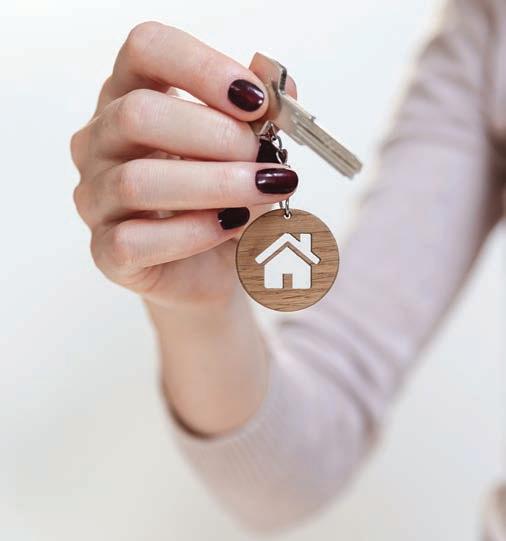




Hello Coasties,
It’s hard to believe that we are at the end of winter! With three July birthdays in our house it’s felt like a blur of cake, balloons and kids on a sugar high! At the end of the winter school holidays I actually wanted another week at home with my kids so I could just hang out with them one–on–one, go figure!
With that said, spring is a mere few weekends away, Father’s Day is just around the corner and the days are itching towards more daylight. As we zoom through the second half of the year, let’s all make sure we take the time to look after the entire family’s wholistic wellbeing –including our own!
With that in mind, check out “Feel better from the inside out with full–body Red Light Therapy” (pg 9) for physical wellbeing, Releasing stress in children – How to support their emotional health” (pg 20) for our little ones and “Step out in style this Spring carnival” (pg 15) for some much needed fun.
Love and light always Coasties!
Art Director/Editor
Tanzie Carpenter tanzie@onthecoastpublications.com.au
Production Luke Carpenter luke@onthecoastpublications.com.au
Editor Jessica Sanford editor@onthecoastpublications.com.au
Publisher Tanzie Carpenter / 0414 611 851 Luke Carpenter / 0405 449 339 trading as On the Coast Publications ABN 52 212 212 482 PO Box 3251, Bateau Bay NSW 2261 onthecoastpublications.com.au
For advertising enquiries advertising@onthecoastpublications.com.au
For article contribution enquiries tanzie@onthecoastpublications.com.au
Printing Spotpress Pty Ltd / 02 9549 1111
Cover image
Crystal Gail Photography crystalgailphotography.com.au
Facebook – crystalgailphotographer Instagram – @crystalgail_photography Imagery freepik.com
Contributors
Sheree Orbell, Mia Eddy, Simon Tarrant, Dorian Mode, Sam Woods, Jordi Woods, Carin Clegg, Blake Gray, Alita Blanchard
4 What the new Family Law changes mean for you

6 A world–class qualification – The International Baccalaureate
9 Feel better from the inside out with full–body Red Light Therapy
10 Financial Accountability: The cornerstone of wealth building
12 When travel plans go sideways – A parent's guide to Mascot's airport hotels
15 Step out in style this Spring carnival
16 Eating to fuel and calm with ADHD and Autism
18 Architecture for success –Preparing your property for sale in 2025
20 Releasing stress in children – How to support their emotional health
Advertisers
– Families are not necessarily those of the editor or publishing staff. While every
responsibility will be
@onthecoastfamilies proudly supported by
Recent reforms affect property settlements, spousal maintenance and even who gets the dog.
BY SHEREE ORBELL, SOLICITOR DIRECTOR AND MIA EDDY, PARALEGAL AT ORBELL FAMILY LAWYERS
If you’re going through a separation or supporting someone who is, recent changes to Australia’s family law system may directly affect you. From property division to financial abuse and even who keeps the family pet, updates to the Family Law Act 1975 (introduced by the Family Law Amendment Act 2024) came into effect on 10 June 2025.
These changes aim to modernise the law, reflect today’s family dynamics, and create clearer, fairer outcomes. Here’s what you need to know.
For the first time, the law now explicitly recognises the effects of family violence when determining financial and property matters.
Importantly, the legislation provides clear examples of economic and financial abuse, such as:
Controlling access to money.
Sabotaging employment or income.
Racking up debt in a partner’s name without consent.
Coercive behaviour in relation to dowries.
When dividing property, the court must now consider how family violence may have affected a person’s contributions during the relationship and their financial circumstances after separation. For instance, if someone was prevented from working or faces ongoing costs due to recovery from abuse, these factors can now influence the settlement.
Courts must also consider family violence when deciding whether spousal maintenance should be paid.

In a welcome shift for animal lovers, pets (specifically companion animals) are no longer treated simply as property. The law now offers a separate framework for determining who keeps the family pet after separation.
Companion animals are those kept primarily for affection, such as a dog or cat. Animals used for work, farming or business are excluded.
The court can now consider:
Who has been the primary carer for the animal.
Any history of abuse or mistreatment.
The emotional attachment of a party or child to the pet.
Each person’s ability to care for the pet going forward.
Importantly, the court cannot make orders for shared care or joint ownership of pets. It must assign sole ownership unless both parties privately agree to other arrangements.
The amendments also broaden the factors the court must consider when dividing property and finances after separation.
These now include:
Reckless or deliberate wasting of money or assets (such as gambling or
gifting large sums).
The reasons for taking on debt, including family loans or irresponsible borrowing.
The housing needs of any children involved in the matter.
This ensures a more realistic, needs–based assessment when determining how assets should be divided.
In a welcome shift for animal lovers, pets (specifically companion animals) are no longer treated simply as property. The law now offers a separate framework for determining who keeps the family pet after separation
Legal proceedings can be stressful, especially when there’s conflict or family violence involved. The new laws allow courts to take a more flexible and less adversarial approach in property and financial cases, provided both
If you’re separating, you are legally required to provide your former partner with full and honest financial information. This includes bank statements, payslips, superannuation details, and information about all assets and debts
parties agree, or the court considers it suitable.
In parenting cases, this less confrontational approach already applies automatically. It allows judges to be more involved in managing proceedings and encourages the use of technology to reduce in–person appearances, especially where safety is a concern.
Strict rules of evidence may also
be relaxed unless the court decides otherwise, making the process less formal and more accessible.
If you’re separating, you are legally required to provide your former partner with full and honest financial information. This includes bank statements, payslips, superannuation details, and information about all assets and debts. This obligation is called the duty of disclosure.
Under the new laws, this duty is now formally embedded in the Family Law Act, which strengthens its legal significance. If a party fails to comply, the court may:
Alter the property division in the other party’s favour.
Order legal costs to be paid.
Impose fines or other penalties.
Arbitration: The reforms introduce a unified list of matters that can be resolved through arbitration, making private resolution more accessible.
Court oversight: Courts now have clearer powers to control how arbitration is conducted, or to end arbitration if safety concerns arise.
If you’re currently going through a separation or thinking about separating, these changes may significantly affect your rights and responsibilities. Whether it’s ensuring financial fairness, protecting yourself from abuse, or deciding who keeps the family dog, the new laws offer more clarity and protection.
Orbell Family Lawyers to speak with one of our experienced solicitors.
Mention this article to receive a free 15–minute discovery call.
Phone: (02) 4314 6080
www.orbellfamilylawyers.com.au info@orbellfamilylawyers.com.au
Liability limited by a scheme approved under Professional Standards Legislation. The information contained in this article is provided for information purposes only and should not be construed as legal advice.


At Central Coast Steiner School, we are committed to nurturing the growth of young people so that they grow into caring, capable and creative adults. Within a supportive community, we provide rich opportunities that enable each student to succeed far beyond the years at school.
Central Coast Steiner School offers the highly regarded International Baccalaureate Diploma (IB Diploma) as our Years 11 and 12 program. We are proud to be the only school on the Central Coast providing this worldclass educational opportunity – an internationally recognised curriculum that prepares students for university and life beyond, setting them apart through both academic excellence and personal growth.
The IB Diploma stands out due to its global focus and depth of learning. The program is structured to develop well-rounded, independent learners who are ready for the challenges of higher education and the wider world. It is known for its broad curriculum, which covers six unique subject groups: language and literature, foreign languages, social sciences, sciences, mathematics, and the arts. One of the most distinct aspects of the IB Diploma is its core components: Theory of Knowledge (TOK), the Extended Essay, and Creativity, Activity, Service (CAS). These are designed to nurture inquiry, research skills, creativity, and community engagement, which are integral to the program and set it
apart from the HSC’s more content–driven approach.
“The IB Diploma isn’t just giving me knowledge - it’s challenging me to think critically, act ethically, and become a more open–minded and confident learner.” – Current Year 11 Student
At the heart of the IB Diploma is the IB Learner Profile, which emphasises developing students into well–rounded individuals. The profile identifies key attributes such as being inquirers, knowledgeable, communicators, principled, balanced and reflective. These qualities are intentionally developed throughout the two year program, ensuring that students emerge not only academically prepared but also as thoughtful, compassionate, and engaged global citizens.
Universities across Australia and the world value IB Diploma graduates for their academic depth and breadth. The IB Diploma’s overall score is converted into an ATAR–equivalent Combined Rank. Universities often prefer IB students due to the program’s holistic
These qualities are intentionally developed throughout the two year program, ensuring that students emerge not only academically prepared but also as thoughtful, compassionate, and engaged global citizens
approach, which cultivates skills beyond the classroom and ensures graduates are ready for both university life and professional success.
A recent study conducted by the Australian Council for Educational Research (ACER) by Hillman, Edwards and Clarke, (2024) found that new research shows: “Australian students who study the International Baccalaureate Diploma have higher university entry rates and course completion than their peers, regardless of their socio–economic background…”


In offering the IB Diploma, the Central Coast Steiner School continues its commitment to providing an education that empowers students to thrive in a complex, interconnected world. The IB Diploma aligns perfectly with the Steiner philosophy of nurturing creative, critical, and independent thinkers, and we take great delight in seeing how our students flourish in this dynamic program.
Scholarships are now open for students entering Year 11 in 2026. To learn more or apply, visit the Central Coast Steiner School website.


Now available at Coastal Rehab Hub Wellness Centre, Erina
We know that between work, school runs, sport, homework and that never-ending mental load, looking after yourself often ends up at the bottom of the list. But what if there was a way to support your body, reduce stress, improve energy and even get better sleep –in just 15 minutes?
Coastal Rehab Hub Wellness Centre is now home to one of the world’s most advanced wellness technologies: the Prism Light Pod, a full–body red light therapy system trusted by athletes, wellness clinics and integrative health professionals around the globe. And this isn’t just a nice–to–have. This is science–backed self–care, and you’ll be one of the first in NSW to access it.
So, what exactly is red light therapy? The Prism Light Pod delivers photobiomodulation (PBM) – a non–invasive, painless therapy that uses specific wavelengths of red and near–infrared light to stimulate cellular repair, reduce inflammation, and improve energy production at the mitochondrial
level (your cells’ energy powerhouse). In simple terms? It helps your body heal, reset and recover faster, from the inside out.
Each session takes just 15 minutes, delivered inside a comfortable full–body bed. You’ll be supported by the expert team at Coastal Rehab Hub Wellness Centre, who understand real-life demands and long–term recovery. Whether you’re managing fatigue, pain or burnout, red light therapy is a gentle, effective option to support your system.
Backed by Science. Made for Life
While red light therapy has been around for decades, the Prism Light Pod takes things to a whole new level. It’s fully automated, TGA–acknowledged in Australia, and supported by thousands of peer–reviewed studies across pain, inflammation, sleep, skin health, mood and more.
It’s also completely non–invasive, with no pain, no heat and no downtime. You’ll walk out feeling clear, calm and recharged.
The wellness you’ve been putting off Kate Perkins, founder of Coastal Rehab
Hub Wellness Centre and a recognised leader in allied health, says the Light Pod offers a different kind of support for busy parents.
“So many of the people we see are always doing everything for everyone else,” says Kate. “They’re exhausted, stressed and running on empty and they just need something that works. Red light therapy is safe, quick and genuinely effective. It’s a small commitment with a big impact.”
The team at Coastal Rehab Hub Wellness Centre will work with you to determine if red light therapy is right for your goals and circumstances. You don’t need a referral, and multi-session packages are available.
Whether you’re recovering from injury, managing a chronic condition, or simply want to feel like yourself again, full–body red light therapy offers a practical, science–backed way to feel better, with zero guilt and maximum benefit.
Now available at Coastal Rehab Hub Wellness Centre, Erina. Call (02) 4312 7033 to learn more.

BY SIMON TARRANT, PRIVATE CLIENT ADVISER AT MORGANS FINANCIAL LIMITED
In the pursuit of financial success, many focus on income, investments, or market trends. Yet, one of the most powerful and often overlooked drivers of long–term wealth is financial accountability. This principle of being responsible, transparent, and intentional with money serves as the foundation upon which sustainable wealth is built.
Financial accountability means actively managing your finances with clarity and discipline. It involves tracking income and expenses, setting financial goals, reviewing progress regularly, and making informed decisions. Whether

for individuals or businesses, it’s about owning financial outcomes and adjusting behaviours to stay aligned with long–term objectives.
1. Clarity and control
Accountability brings visibility to your financial situation. By tracking spending and income, you gain control over your cash flow. This clarity helps identify wasteful habits, uncover hidden costs, and ensure that money is being used effectively.
2. Goal alignment
Wealth isn’t built by accident, it requires planning. Financial accountability ensures that your daily financial decisions support your broader goals, whether that’s buying a home, retiring early, or growing a business. It keeps you focused and prevents impulsive choices that derail progress.

3. Improved decision–making
When you’re accountable, you’re more likely to evaluate financial decisions critically. Should you invest in a new opportunity? Can you afford a luxury purchase? Accountability encourages thoughtful analysis rather than emotional spending.
4. Reduced debt and increased savings
Accountable individuals tend to avoid unnecessary debt and prioritise saving. By consistently reviewing financial commitments, they can pay down liabilities faster and build emergency funds, which are essential for financial resilience.
5. Trust and credibility
For businesses, financial accountability builds trust with clients, stakeholders, and regulators. Transparent reporting and responsible management signal integrity and professionalism qualities

By tracking spending and income, you gain control over your cash flow. This clarity helps identify wasteful habits, uncover hidden
costs, and ensure that
money is
being used
that attract investment and long–term partnerships.
Create a budget: Start with a realistic budget that reflects your income, expenses, and savings goals. Review it monthly and adjust as needed.
Use financial tools: Leverage apps or spreadsheets to track spending and monitor progress. Automation can help maintain consistency.
Set clear goals: Define short-term and long–term financial goals. Break them into actionable steps and celebrate milestones.
Review regularly: Schedule monthly or quarterly reviews to assess performance. Look for trends, successes, and areas for improvement.

Seek advice: Work with financial advisers or mentors who can provide guidance and hold you accountable.
Over time, financial accountability compounds. Small, consistent actions like saving a portion of income, avoiding unnecessary debt, and investing wisely lead to significant financial growth. It’s not about
perfection, but about persistence and responsibility.
In essence, financial accountability transforms money from a source of stress into a tool for empowerment. It’s the quiet discipline behind every successful financial journey, and for those committed to building wealth, it’s an indispensable ally.
effectively If you would like to discuss your family’s financial strategy please contact Simon at simon.tarrant@morgans.com.au or via (02) 4325 0884. Morgans Financial Limited 4/168 The Central Coast Hwy, Erina NSW 2250 morgans.com.au/erina
Simon Tarrant (AR: 001270872) is a Private Client Adviser at Morgans Financial Limited (AFSL 235410 /ABN 49 010 669 726). Simon is passionate about creating quality financial strategies that are tailored and customised to a clients’ lifestyle, financial goals and risk profile. Disclaimer: While every care has been taken, Morgans Financial Limited makes no representations as to the accuracy or completeness of the contents. The information is of a general nature only and has been prepared without consideration of your individual objectives, financial situation or needs. Before making any decisions, you should consider the appropriateness for your personal investment objectives, financial situation or individual needs. We recommend you see a financial adviser, registered tax agent or legal adviser before making any decisions based on this information.

WORDS BY DORIAN MODE

“Due to an electrical fault,” the captain’s voice crackles through the cabin speakers, “we’ll be returning to Sydney.” My wife and I lock eyes, a silent conversation of dread passing between us.
Five hours into what should have been a straightforward 7–hour flight to Broome (no engineers in Broome, apparently), I’m staring at the prospect of an unexpected overnight at Sydney Airport with a plane full of equally bewildered passengers. Some are frantically rebooking connections online, others are resignedly opening novels. But spare a thought for the families with small children, suddenly facing the unique challenge of explaining to a five–year–old why they’re sleeping at the airport instead of building sandcastles in the sunset.
This is where airport hotels become more than just accommodation –they transform into family crisis management centres.
The tale of two mascots Sydney’s Mascot precinct offers two distinctly different solutions for stranded families: the budget–conscious Travelodge Sydney Airport and the decidedly more upmarket Adina Apartment Hotel Sydney Airport. Both sit tantalisingly close to the terminal, yet
worlds apart in what they offer families navigating travel chaos.
Picture this common scenario: Flight delayed six hours. Kids melting down in the departure lounge. The airline offers vouchers for an airport hotel. Do you grab the sensible option or throw caution to the wind and upgrade yourselves out of travel misery?
The Travelodge Sydney Airport sits exactly where you’d expect a budget airport hotel to sit – close enough to hear the planes, far enough from the action to forget you’re in transit purgatory. For families, this is often exactly what’s needed.
The rooms are refreshingly straightforward. No confusing gadgets for curious fingers to break, no white furniture to show every sticky hand print. The beds are sturdy enough to handle impromptu jumping sessions (though obviously, you don’t encourage such behaviour). Most importantly, the layout actually makes sense – you can see the entire room from the door, crucial when you’re doing that parent head–count every thirty seconds.
The real winner here is the practicality. Need extra towels because someone decided bath time was also swimming time? No problem. Forgot to pack the night light and now nobody’s
sleeping? Reception can usually help. The staff understand that families in hotels aren’t on holiday – they’re in survival mode.
But perhaps the hotel’s greatest asset is its honesty about what it is. This isn’t trying to be a resort experience. It’s a clean, safe, functional place to reset before continuing your journey. Sometimes, that’s exactly what overwhelmed parents need most.
Then there’s the Adina Apartment Hotel Sydney Airport, where my own electrical fault adventure landed me. After hours of travel anxiety, walking into those spacious apartment–style suites felt like being handed a get–out–of–jail–free card.
The kitchenette alone is worth the upgrade when you’re dealing with children. Suddenly, you’re not at the mercy of room service timing or hunting for kid–friendly snacks at midnight. You can heat milk, store medication properly, and make actual coffee.
The separate living area transforms everything. Instead of everyone cramped on beds watching cartoons on a tiny screen, families can spread out. Kids can play on the floor while parents maintain some semblance of adult conversation. The space actually breathes.


The real luxury, though, is the washing machine and dryer in every apartment. When you’re travelling with children, clean clothes are currency. That outfit disaster on the plane? The mysterious stain from lunch? Suddenly manageable instead of trip–ruining.
The midnight munchies factor
Both hotels understand that families operate on different schedules than business travellers. The Travelodge keeps things simple with 24–hour vending and a decent café that opens early enough for those awful 6AM flights. Nothing fancy, but when you need a banana and a coffee at 5:30AM, fancy isn’t the point.
The Adina takes a different approach with its full kitchen facilities and nearby dining options. The adjacent shopping centre means you can stock up on familiar snacks and drinks—essential

when you’re dealing with picky eaters who consider airplane food a personal insult.
The morning after reality
Here’s where both hotels shine: they understand the airport hotel checkout dance. Need to store luggage while you explore Sydney for the day? Sorted. Want to grab one last coffee before facing security again? Both hotels position you perfectly for a civilised departure rather than a frantic sprint.
The shuttle services run frequently enough that you’re not watching planes take off while waiting for the next bus. Though honestly, after a night of decent sleep, even that stress feels manageable.
The truth is, both hotels serve families well, just in different ways. The
Travelodge is the reliable friend who shows up with pizza when you need help moving house. The Adina is the friend who arrives with pizza, wine, and offers to help you organise your entire life.
For families on a tight budget or dealing with very young children who’ll sleep anywhere, the Travelodge delivers exactly what’s needed without fuss. For those who want to turn a travel disaster into something approaching a mini–break, the Adina’s apartment–style setup can genuinely transform the experience.
Either way, you’re sleeping somewhere other than the airport floor. After five hours on a plane that turned around mid–flight, that’s what we call a win.
TRAVELODGE SYDNEY AIRPORT | travelodge.com.au
Address: Corner of Bourke Street and Robey Street, Mascot | Family rooms: Available with double bed plus bunk beds | Kitchen facilities: None in standard rooms | Shuttle: Complimentary to airport (5-minute ride) | Best for: Budget–conscious families, short stays
ADINA APARTMENT HOTEL SYDNEY AIRPORT | adinahotels.com
Address: 17 Bourke Street, Mascot | Family accommodation: One and two-bedroom apartments | Kitchen facilities: Full kitchenette with washing machine/dryer | Shuttle: Complimentary to airport (5–minute ride) | Best for: Longer stays, families needing space
GETTING THERE | Both hotels are approximately 8km from Sydney CBD and offer courtesy shuttles to the airport. The nearby train station (Mascot) connects to the Airport Link if you’re heading into the city.
PRO TIPS FOR FAMILIES • Book ground floor rooms when possible – easier with luggage and strollers
• Both hotels are within walking distance of a supermarket • Airport pickup can be arranged, but allow extra time during peak periods • Check airline voucher acceptance policies before booking
TRAVELODGE HOTEL SYDNEY AIRPORT:
Official TFE Hotels site: https://www.tfehotels.com/en/hotels/travelodge-hotels/sydney-airport/ Direct booking site: https://travelodge.com.au/book-accommodation/sydney/hotel-sydney-airport/
ADINA APARTMENT HOTEL SYDNEY AIRPORT: Official TFE Hotels site: https://www.tfehotels.com/en/hotels/adina-apartment-hotels/sydney-airport/ Direct Adina booking site: https://www.adinahotels.com/en/apartments/sydney-airport/


BY SAM & JORDI WOODS
Are you ready to hit the trackside this Spring Carnival or are you feeling a little overwhelmed at the prospect of all the effort it takes? What if we told you that it can take very little effort, all you need to know is how to simplify getting dressed to ensure the experience is fun and stress free.
Abide by event dress code and/or colour theme: Quite often race days (and events in general) will have a dress code, colour theme or overall theme. If you are unsure there is nothing wrong with contacting someone and asking what it is. The reason it is so important that you look at the theme is it will give you a guideline of what to wear and save you angst of feeling out of place if you show up in something inappropriate for the day. It is also a sign of respect for the organisers and good social etiquette.
Pictured Jordi has dressed for several different Race Day themes. Image 1: Jordi gave a “Blue & A Touch Of Gold” Dress Code a Western style. Image 2: “Pretty & Pastel” Dress Code. Image 3: “Bold & Bright” Theme
Be appropriate:
If you are abiding by the dress code this should be less of an issue as you are dressing accordingly. However, a big thing to consider is don’t have any bad distractions as this can then make your outfit look inappropriate! For example; this could be too much skin showing, bad underwear choices, wrong colours/ styles for your complexion and figure, inappropriate dress code.
Good grooming and neat attire:
No matter what you wear good grooming is an essential part of “appropriate dressing” and will ensure an overall stylish appearance.
Always ensure shoes and bags are in good condition and comfortable to walk in.
Have a mini emergency kit in your handbag for those unexpected mishaps. Maybe include: bandaids, safety pins, bobby pins, invisible tape, touch up lippy and powder.
Ensure nails are clean and if possible a coat of clear or coloured nail lacquer.
Tip: Have a look in a full length mirror before you leave home to ensure everything is just where it should be!
Always wear some form of headwear: It is respectful and expected for race days to wear some form of headwear, this could be a fascinator, headband, hat, hair clips or bow.
Tip: Always ensure that your headwear compliments your


outfit, colour palette (as your headwear will frame your face and features) and expresses your personal style!
Re–work what you have:

Race days and special occasion dressing does not mean you need to buy a whole new outfit. Loan, hire or re-work items from your existing wardrobe. Get creative and play with what you have by mixing pieces and dressing them up with accessories. It makes the process much less stressful when you don’t need to spend extra money or time on shopping for something new.
Note: In image 3 Jordi and Sam reworked business blazers to create race day looks with dresses they have worn to other special occasions.
Remember, going out should be a fun experience not a stressful one. So plan ahead, think outside the box, make sure you are comfortable in what you wear and have fun stepping out in style this Spring Carnival!
Vibrantly yours, Sam & Jordi Woods xx
Note: The tips we have outlined for you in this article can also be applied to everyday and other special occasion dressing too.
Understanding styling and fashion is one thing. Having a super natural flair for making everyday people look incredible is another. Once you’ve met Sam and Jordi Woods, it’s hard not to catch their infectious passion for dressing to match your own lifestyle, personality and charisma. Through their consultancy ‘Vibrant Concepts’, Sam and Jordi have transformed the lives of thousands. Let Sam and Jordi show you how to look and feel fabulous everyday at their Style Studio in Erina – learn the art of illusion dressing, colour matching, styling, translating fashion trends and savvy shopping with their unique VC Signature Styling Systems and services that are truly personal and really work! To contact Vibrant Concepts phone 0425 221 676
BY CARIN CLEGG DIETITIAN/NUTRITIONIST AT BRIGHT DIETS
Autism, ADHD and anxiety can often go hand–in–hand and food plays a huge role.
When the appetite is good, good nutrition will assist the body and mind to function optimally. Eating regular meals and snacks helps to train and maintain a good appetite.
Natural hunger and satiety regulation can be disturbed by many things:
Over eating: including eating ‘sometimes’ foods and drinks. Unfortunately, there is little room in kid’s appetites for ‘sometimes’ foods as they displace appetite for nutritious foods their growing body needs.
Under-eating or a poor appetite: can be caused by skipping meals, medication, stress and anxiety, food intolerance, gut issues and needs to be addressed, to obtain a sense of bodily calmness.
Grazing: occurs when we eat less than 2–3 hourly. It can stop someone feeling hungry for a proper meal and could be unknowingly done to manage an upset tummy which may

be mistaken for hunger. Kids can either under–eat or over–eat when grazing. They may be the fruit bat or the cruncher, releasing anxiety with crunchy foods.
Nutrition deficiencies: such as iron, zinc, magnesium, and vitamin D can contribute to poor appetite, anxiety, depression, poor concentration, irritability, emotional dysregulation, sensory processing issues and more. Treating these can optimise mood, appetite and physical and cognitive function.
Routine is so important to help us all feel calm and in control. When we expect something to happen at the same time each day, we do not need to think. We do not become overwhelmed from decision making and this helps us feel settled and calm.
Eating regularly i.e. every 3–4 hours, helps to fuel or give energy to our body and brain to function optimally. Eating

regular meals and snacks helps us to manage our emotions by not being hungry over the day and by fuelling our brain.
Eating regular meals and snacks helps to train and maintain a good appetite
Skipping meals and snacks, can cause tiredness, irritability and further impact our ability to eat all the nutrients our body needs.
Eating regularly over the day gives kids many opportunities to eat the range of different foods their bodies need to grow and thrive. Even if they only like a handful of different fruits and vegetables, that is OK. They likely love the routine and familiarity of it.
Having a routine around what foods kids are offered each meal or snack time can also be a welcome comfort. Such as having only 2 choices of breakfast for the week days such as Weetbix or porridge with an option for a different fruit if available.
The foods kids choose can change depending on their level of calmness. You may have noticed at the beginning of the school term, kids just want the same foods in their lunch box or at the end of a hard day they want their comfort easy–to–eat foods. Whereas,
Routine is so important to help us all feel calm and in control. When we expect something to happen at the same time each day, we do not need to think. We do not become overwhelmed from decision making and this helps us feel settled and calm
when they are settled into the school routine and are having an easy week, they become more adventurous with their food choices.
A common problem with many kids is fussy eating and often this is something that can cause a lot of stress at mealtimes for families. There are many causes of fussy eating including: gut issues, nutrition deficiencies, poor appetite, sensory processing, poor concentration, lack of routine, lack of role modelling, stress, food intolerance or simply wanting independence, choice and control over their meals.
Eating together and always providing foods everyone likes to make mealtimes enjoyable can assist kids to feel more at ease at meal times.
Food components and flavours from the breastfeeding mother’s diet comes through the breastmilk to bub

and can often cause issues. In my experience, when the diet is right from the get go, including when the breastfeeding mother’s diet is right, there will be minimal issues around sleep, breastfeeding, colic and unsettled behaviour.
When I see clients, a good nutrition assessment gives clues as to what might be contributing to various symptoms which can impact the nervous system, gut issues, poor appetite, insatiable appetite (hungry baby), emotional dysregulation, poor concentration, behaviour issues, sleep issues, bed wetting, rashes, blocked noses, as well as food dislikes and likes, including fussy eating behaviour.
When toddlers eat more variety, are sick and take flavoured medications, are cared for by others, attend childcare/ kindergarten, ‘sometimes’ foods, eating out and takeaway foods are introduced, their diet changes slowly and gradually over time and symptoms also develop slowly and gradually over time without

realising cause and effect.
The current evidence says, the majority of young children react with behaviour and mood changes from certain additives. Some children also react to strong flavours like acidic foods, concentrated fruit flavours, spices, and chocolate to name a few. We also know that if people are sensitive to dairy, soy, or wheat, they are also highly likely sensitive to some of the other previously mentioned food components.
Food and the reasons why kids eat is so complex. Seeking expert guidance can help everyone in the family feel the best they can with the power of food.
Bright Diets 0413 774 411
dietitians@brightdiets.com.au 470 Pacific Highway, Wyoming, NSW, 2250 brightdiets.com.au Bright Diets brightdiets

Carin Clegg is the Director of Bright Diets, is a Paediatric Dietitian and Fitness Professional with an interest in sustainability. Carin wants everyone to be clever about their eating to feel happy, healthy and vibrant!
Reach out at 0413 774 411, on the socials or at www.brightdiets.com.au
BY BLAKE GRAY, PRINCIPAL AT APEX ESTATE AGENTS
There’s a lot of noise in and surrounding real estate. It dominates the news cycle year round – in print, on television, in the peripheries of casual conversation and of course online. It has and always has had a litany of voices contributing to the subject.
For the legions of gurus who purport to offer – shall we say – what they claim to be the ‘secret formula’ one would think that with all this information at hand, real estate related decision-making should be far less difficult. Alas, the clutter grows. Perhaps you’re looking to prepare your home to sell in order to upsize, to rezone for the desired schools, or quite simply you just intuit that a change would be beneficial for you and your family. If so then this article is for you. At its core it aims to declutter some of this noise and to impart what is objectively sound general information only, for those on the Central Coast wishing to prepare their home for sale and to maximise the sale price of their property as we transition into spring in the second half of 2025. The information herein is not wholly comprehensive, but will get you started.
Both natural and artificial light enhance any space, but in slightly varying ways. Natural light increases the perceived volume of the space – making it appear larger. While artificial light builds depth and drama.
Focus on removing cumbersome, heavy, or excessive window coverings.
Add floor/table lamps to create drama, contrast and to set the mood in rooms where a focal point is needed.
Consider the use of wall/freestanding

mirrors to spread light around and to give the illusion of space – mirrors are very popular right now.
It’s also important to consider the type of artificial light being added. Use cool light in common areas like kitchens, foyers, hallways and rumpus rooms; and warm light for more intimate spaces like bedrooms, bathrooms, home offices and formal dining areas.
An external photo is usually the first interaction a buyer will have with your property. Ironically it’s often the case that sellers will invest the majority of their efforts preparing the inside and outside of the property for the sale. All the while neglecting the grounds, gardens and outdoor spaces. First impressions are lasting ones. For some perspective: sellers that prioritise this work will commonly receive tens of thousands of dollars more in offers from buyers – making this an economical yet fruitful enterprise.
Ensure lawns are level.
Driveways and footpaths must appear serviceable and cared for.
Gardens need to look manicured and fresh (new mulch or pebble does wonders).
Add colour and energy with a new letterbox or decorative pots along any straight line surface (porches, entryways, driveways, outdoor patio spaces etc).
All fencing must be uniform in colour and quality where possible.
Properties that feature pools/spas and that are located next to or in close proximity to water will attract more attention and more clicks. Make an effort to associate your property with water in some way
Buyers instinctively crave exclusivity. Rare things carry value. Individuality sells. For this reason, establishing a POD for your property is vital. A simple yet effective method for achieving this is to give your property a name. The name should feature throughout your campaign and appear on all forms of media concerning the property. Where possible source a small sign or plaque with the name on it and place it in plain view for all buyers to see when at your open home(s). This will positively isolate your property, adorning it with immediate credibility – thus leveraging its value.
Current trends on the Central Coast show that buyers have their sights set on two primary property types – original homes and completely renovated ones. Therefore properties that sit somewhere between these two types will find it more difficult to connect with buyers
The data is clear. Properties that feature pools/spas and that are located next to or in close proximity to water will attract more attention and more clicks. Make an effort to associate your property with water in some way. Here are some ideas.
Make sure the lead image for your campaign shows the pool/spa, or the distance to the beach/lake/water with a drone photo.
Add a sign outside the property pointing to, ‘the beach’ or ‘the jetty’.
Add an outdoor shower.
Include artwork or interior decor that hints at the nearby water.
Borrow a surfboard from a neighbour/friend and include this in your exterior styling (at least until after the photos have been taken).
Knowing what renovations – either cosmetic or structural – to undertake in the preparation of your home for sale is typically the question that troubles sellers the most. The answers given to this question are generally vague and

unsatisfactory. Current trends on the Central Coast show that buyers have their sights set on two primary property types – original homes and completely renovated ones. Therefore properties that sit somewhere between these two types will find it more difficult to connect with buyers –resulting in fewer/lower offers. This is where the input of a local real estate professional with exceptional and up–to–date knowledge of your suburb will be of great utility. The below points should provide some sort of general clarification to help you ascertain what work to undertake and thus to avoid what is unnecessary.
If your property is mostly in original condition then your focus should simply be to rectify any obvious issues that may cause a buyer to hesitate in placing an offer.
If you’ve already completed some home improvements and do not wish to continue with your renovation, it is worthwhile to remember that the old cannot spoil the new. In cases like this select a dominant colour or texture. This colour must feature in all spaces (renovated and original alike). It will bridge the gap between them – ultimately easing the harsh
contrast between the old and new.
Again, there’s much to consider on this question. Speak to your real estate professional. They will advise further on matters concerning, Cost vs Return; Timing vs Cost; and on Demand vs Seller preference.
Now, it’s time to get excited about your next chapter..

BY ALITA BLANCHARD, NERVOUS SYSTEM–INFORMED PARENT COUNSELLOR
So many of us are doing the best we can to raise kind, resilient, emotionally healthy children – and often in a world that doesn’t value the immense amount of energy this takes whilst also trying to care for ourselves. But the truth is, parenting can feel so hard – especially when your child seems extra sensitive, anxious, or overwhelmed.
Some children carry more stress in their little bodies than others. This can show up as big emotions, constant meltdowns, fears that don’t make sense, trouble sleeping, or even things like aggression and control–seeking behaviour. If this sounds familiar, you’re not alone.
In this article, I want to offer you some insights into why our kids carry stress – and what we can do to help them release it in ways that feel safe, connected, and supportive. This isn’t about fixing our children, but helping them feel more at home in their bodies.
Why do children hold on to stress?
Stress doesn’t just come from the big, obvious things. Many children today are holding onto layers of tension they can’t put words to. This might include:
Stress in pregnancy (amplified during the COVID years).
Birth or medical trauma.
Separation from their primary caregiver.
Family conflict or a stressful home environment.
Anxiety, depression or burnout in a parent.
Overstimulation, too many transitions, or inconsistent routines.
Sometimes it’s not one major thing – but a build up of small stressors over time. And when we, as parents, are also running on empty, that stress gets passed on, even if we don’t mean to.
How stress shows up in children
Kids don’t say, “I feel dysregulated” or “life is too busy and hard” – They show it in their behaviour. You might see:
Constant anxiety, fears or clinginess.
Trouble sleeping.
Chewing, biting nails or repetitive habits.
Anger or hitting.
Meltdowns over small things.
Refusal to follow instructions or high need for control.
These aren’t signs your child is “bad”—they’re signs they’re holding onto something inside that needs space to move.
What helps children release stress?
Here are some simple, everyday ways to help your child release stored stress and tension:
1. Let the body lead
Children process emotion through movement, not just words.
Rough and tumble play: Chase games, pillow fights, or wrestling help discharge energy.
Jumping, bouncing or swinging: Activities that move the body rhythmically help regulate the nervous system.
Sensory play: Crunchy snacks, chewing gum, or fidget toys offer soothing feedback to the body and help with regulation.
Think of it this way: when a child is aggressive or wild, they don’t need punishment. They need movement and connection to bring their system back into balance. Sometimes, they also need us to show up to offer our body as the boundary, keep others and them safe, contain the situation and ride the storm of their emotions (some of the hardest work of parenting right there

– especially if aggression is triggering for you, which it is for many, especially women!)
2. Emotional expression is healthy Tears, raging, meltdowns, yelling, and frustration aren’t the problem – what matters is whether your child feels safe enough to express them. Even physical and verbal aggression are developmentally appropriate at certain ages and stages.
Let them cry without rushing to fix it: Allow the tears. Say “your feelings are safe with me”.
Acknowledge the feeling: “You’re really upset. That makes sense.”
Stay close and grounded as their storm passes. You don’t need to have the perfect words. You just need to be a steady presence. Practice practice practice. Repair when it goes pear shaped (and it will!)
3. Set clear boundaries (firm but kind) Children feel safe when adults are in charge. That doesn’t mean being harsh—it means being clear.
“It’s ok to feel angry, but I won’t let you hurt me/others.”
“I’m here. You can roar, but I’ll protect your body. ” Boundaries help the nervous system feel secure. So does your warmth.
4. Reconnect often Kids feel calmer when they feel connected to us.
After daycare or school, try not to rush them : Offer eye contact, hugs, and gentle presence. Snacks. Slow transitions and frontloading (speak what is happening next). More sensitively wired kids will have meltdowns after big days at school –they are releasing emotional gunk and overwhelm. Learn to stay present for it.
Create small rituals for reconnection: stories, cuddles, play, shared snacks. Connection fills their cup and gives them a safe place to land.
5. Look at the bigger picture
Sometimes, your child is reacting to stress that’s not even theirs. Family tension, burnout, or overwhelm in the home can impact them deeply.
How are you doing? Are you supported?
Is the household too fast-paced, loud or disconnected?
Are your child’s caregivers people they feel truly safe with? When we work to reduce background stress, kids settle more easily. Building resilience, slowly Helping your child release stress isn’t about pushing them. It’s about creating space for slow, gentle growth.
Let them face little challenges with your support.
And what about you?
Your nervous system matters too. You’re not a robot. If you’re feeling stuck, overwhelmed, reactive – name it.
“I’m burnt out.”
“I feel alone.”
“I don’t know what to do.” This isn’t failure. It’s a cue that you need co–regulation too. Find a circle. A counsellor. A friend who gets it. You are allowed to need help.
And as you tend to them – please tend to yourself too. If you don’t know where to start, start with reaching out to one safe person and saying “I need some help”. We all need help on this journey and so many are willing to support you, just ask.
For more local parenting support, counselling or 1:1 sessions, visit www.theawaremama.com.au and sign up to Aware Mama news to a free ebook on Radical Self Care tips.
Encourage independent play: this can take years and is harder for some kids Remind them that all feelings are ok, and they aren’t alone. Stress release isn’t about forcing calm— it’s about creating conditions for safety. Children who feel safe, seen, and supported will slowly begin to release what they’ve been holding.
Alita Blanchard, The Aware Mama Based on the NSW Central Coast, Alita is a mother of 4 boys, Holistic Counsellor, Nervous system informed Parent Coach and Emotional Release practitioner. She holds regular mothers circles, online programs and offers 1;1 support for parents. Instagram: @alitablanchard_ | hello@theawaremama.com.au | www.theawaremama.com.au




